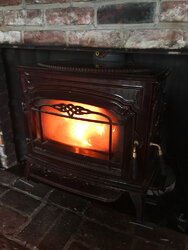Quadrafire Yosemite used as a top vent hearth stove

25’ SS liner, insulated.
The draft on this thing is insane. I went as far as to replace every single gasket I could find, and dollar bill tested everything.
If I don’t turn the air down immediately on a full load, it runs away. Once the secondaries are firing it’s basically a blow torch. My other quad had nice secondaries, that seemed controllable. This one looks like an out of control weed burner.
Mind you, my wood is NOT properly seasoned this year. I’m a little worried about what next year will look like with dry wood.
Has anyone found a pipe damper solution for an install like this?
Dustin

25’ SS liner, insulated.
The draft on this thing is insane. I went as far as to replace every single gasket I could find, and dollar bill tested everything.
If I don’t turn the air down immediately on a full load, it runs away. Once the secondaries are firing it’s basically a blow torch. My other quad had nice secondaries, that seemed controllable. This one looks like an out of control weed burner.
Mind you, my wood is NOT properly seasoned this year. I’m a little worried about what next year will look like with dry wood.
Has anyone found a pipe damper solution for an install like this?
Dustin
Last edited by a moderator:

